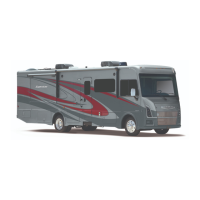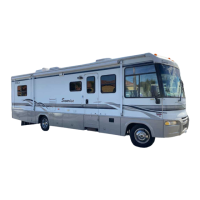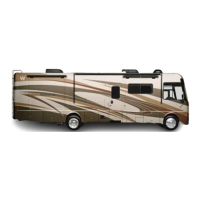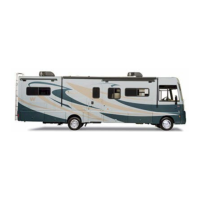
Do you have a question about the Winnebago Sunstar and is the answer not in the manual?
| Fuel Type | Gasoline |
|---|---|
| Category | Class A |
| Manufacturer | Winnebago |
| Model | Sunstar |
| Chassis | Ford |
| Transmission | Automatic |
| Generator | Onan |
| Sleeps | 5-7 (depending on model) |
Overview of the operator manual's purpose and content.
Explanation of safety alert symbols (Danger, Warning, Caution, Note).
Details on the pre-delivery inspection process performed by the dealer.
Recommendation for checking and adjusting front axle alignment.
Information on obtaining dealer support and warranty repairs.
Explanation of the data and importance of the vehicle certification label.
Technical specifications and fluid capacities for different models.
Section for recording owner, vehicle, and dealer contact details.
Details of the basic, structural, and limited warranties for the motor home.
Essential safety guidelines for operating the vehicle and its systems.
Precautions and best practices for safe motor home operation.
Critical safety information regarding the use of fuel and propane gas.
Procedures to follow if propane gas leaks are detected inside the vehicle.
Information on the function and location of the propane gas leak detector.
Precautions against carbon monoxide and details on the CO alarm system.
Information about the smoke alarm's operation, testing, and replacement.
Location, inspection, and replacement guidelines for the fire extinguisher.
Key safety precautions for handling electrical components and systems.
Guidelines for safely storing and securing items within the vehicle.
Safety precautions related to vehicle maintenance procedures.
Instructions on how to operate emergency exit windows.
Information regarding formaldehyde emissions and health considerations.
Guidance on preventing and dealing with mold growth due to moisture.
Procedures and advice for handling roadside emergencies like flat tires.
Instructions for jump starting the engine using the battery boost switch.
Actions to take if the engine overheats to prevent damage or injury.
Instructions for adjusting and swiveling the driver and co-pilot seats.
Proper use, care, and importance of seat belts for all occupants.
Guidelines for selecting and properly installing child restraint systems.
Information regarding the types of keys provided with the vehicle.
Operation of the rearview camera system for maneuvering assistance.
Adjusting power electric mirrors for maximum rear visibility.
How to apply and release the foot-pedal park brake.
Explanation of the Tow/Haul mode for improved towing performance.
Operating the driver's side map light.
Function and use of hazard warning flashers for safety.
Using the battery boost switch to start the engine from house batteries.
Operating the dash climate control system for the cab area.
Basic operation and features of the in-dash radio system.
How to access the engine compartment from the outside.
How to remove the interior front engine cover for access.
Checking and maintaining the engine's cooling system and coolant.
Function and operation of the switch that disconnects chassis batteries.
Importance of proper tire pressure and wear for safety and economy.
Guidance on alignment checks and tire balancing for optimal performance.
Checking exterior lights and troubleshooting bulb or fuse issues.
Location and function of automotive fuses and circuit breakers.
Special techniques for climbing and descending hills in mountainous terrain.
How to operate the refrigerator on electric or propane, including leveling.
Accessing the exterior compartment for refrigerator inspection and service.
Operating the propane range and oven, including lighting instructions.
Information on the range hood's function for ventilation and lighting.
Using the monitor panel to check tank levels, battery charge, and system status.
Operating instructions for the gas water heater and its safety features.
How to start up and operate the propane gas furnace.
Operation of the air conditioning system, including thermostat and vent control.
How the EMS monitors and distributes electrical loads for efficient operation.
Selecting the correct power source for the rear air conditioner unit.
Chart detailing thermostat functions for heating and cooling modes.
Overview of the propane system, how it works, and tank features.
Procedure and safety notes for refilling the vehicle's propane tank.
Recommendation for using straight propane and avoiding butane mixtures.
Essential safety precautions for using the propane gas system.
Important warnings and legal requirements for propane tank usage.
Information on the pressure regulator's function, protection, and maintenance.
Understanding propane vaporization issues and solutions in cold weather.
Critical safety warnings for handling electrical components and systems.
Operation of the 120-volt AC system from shore or generator power.
Connecting the external power cord and ensuring proper grounding.
Overview of the power center, converter, and charging sections.
How circuit breakers protect the 120-volt system from overloads.
Information on 120-volt outlets and the function of GFCI protection.
Operation and safety guidelines for the 120-volt generator.
Components and power sources of the 12-volt DC system.
Purpose and operation of the switch to disconnect house batteries.
Location of house batteries and essential battery maintenance practices.
Protection for 12-volt circuits using fuses and breakers.
Overview of the fresh water system, sources, and filling procedures.
How the demand water pump works and its self-priming capability.
Procedure for disinfecting the potable water system with bleach.
Explanation of the shower hose vacuum breaker function.
Using the RV toilet, including important 'don'ts' for care.
Description of self-contained holding tanks for waste water.
Step-by-step instructions for safely dumping waste water holding tanks.
Location and use of drain valves for water lines and tanks.
Function and use of the bypass valve for winterization.
Methods for winterizing the plumbing system using air or antifreeze.
Diagram and list of locations for all water system drain valves.
Connection cables for audio/video systems and optional TV.
How the front TV operates only when the ignition is off or in accessory.
Operation of video players in rear bunk models.
Raising, rotating, and lowering the TV antenna for optimal reception.
How to turn on and check the TV signal amplifier.
Information on pre-wiring for digital satellite TV system installation.
Location of exterior jacks for satellite and cable TV connections.
Operation and safety precautions for the swivel glider lounge chair.
Warning against using sleeping facilities while the vehicle is moving.
Instructions for converting the sofa to a bed and vice versa.
How to convert the dinette to a bed and back to dinette configuration.
Converting the U-shaped dinette into additional sleeping space.
Information on the types of wood used and their characteristics.
Securing the slideout room for travel using the prop-lock rod.
Importance of turning the master keylock on for slideout control.
Operating slideout rooms using electric motors and control switches.
Recommendations for protecting slideout rooms during extreme weather.
Troubleshooting electric slideout room issues related to battery or circuit breakers.
Manual procedures for retracting slideout rooms in case of electrical failure.
Tips for maintaining slideout room seals and cleaning floors before retracting.
Overview of the hydraulic leveling system for parking site adjustment.
Procedure for checking the hydraulic oil level in the leveling system.
Importance of inspecting and maintaining sealants to prevent water intrusion.
Safety warnings and precautions for working on the vehicle roof.
Cleaning the undercarriage to prevent rust and corrosion.
Tips for cleaning and preserving the vehicle's gel-coated fiberglass finish.
Recommendations for washing, waxing, and polishing the exterior finish.
Maintenance guidelines for exterior appliques and decals.
Proper cleaning methods for various plastic interior and exterior parts.
Routine cleaning and maintenance for fabric and vinyl interior softgoods.
Stain removal guide for ceiling fabric materials.
Cleaning instructions for wooden cabinetry and furniture surfaces.
Maintaining tables and countertops with cleaning and waxing.
Cleaning and care instructions for the acrylic galley sink.
How to clean bathroom tub and shower walls properly.
Cleaning and lubricating doors and windows for smooth operation.
Steps to prepare the motor home for storage to prevent damage.
Steps for preparing the vehicle after storage, including system checks.
Recommended maintenance schedule for various coach systems and components.
Diagram showing locations and types of sealants used on the coach exterior.
Guidelines for distributing cargo load to respect weight ratings.
How and where to weigh the fully loaded coach for proper distribution.
Method for determining weight distribution on each corner of the coach.
Capacity ratings and considerations for towing vehicles or trailers.
Proper connection of trailer or tow vehicle wiring to the coach.
Understanding Gross Vehicle Weight Rating (GVWR) and Gross Axle Weight Rating (GAWR).
Operation and safety for the electric entry step.
How to operate crank-out and slider windows.
Managing condensation and humidity during extended stays.
Steps to reduce excessive moisture and condensation inside the coach.










